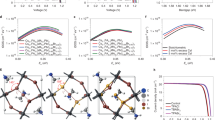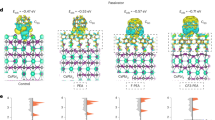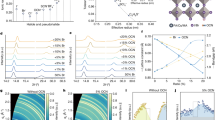Abstract
Organic–inorganic halide perovskite materials have emerged as attractive alternatives to conventional solar cell building blocks. Their high light absorption coefficients and long diffusion lengths suggest high power conversion efficiencies1,2,3,4,5, and indeed perovskite-based single bandgap and tandem solar cell designs have yielded impressive performances1,2,3,4,5,6,7,8,9,10,11,12,13,14,15,16. One approach to further enhance solar spectrum utilization is the graded bandgap, but this has not been previously achieved for perovskites. In this study, we demonstrate graded bandgap perovskite solar cells with steady-state conversion efficiencies averaging 18.4%, with a best of 21.7%, all without reflective coatings. An analysis of the experimental data yields high fill factors of ∼75% and high short-circuit current densities up to 42.1 mA cm−2. The cells are based on an architecture of two perovskite layers (CH3NH3SnI3 and CH3NH3PbI3−xBrx), incorporating GaN, monolayer hexagonal boron nitride, and graphene aerogel.
This is a preview of subscription content, access via your institution
Access options
Subscribe to this journal
Receive 12 print issues and online access
$259.00 per year
only $21.58 per issue
Buy this article
- Purchase on Springer Link
- Instant access to full article PDF
Prices may be subject to local taxes which are calculated during checkout




Similar content being viewed by others
Change history
20 December 2017
The authors of the study are retracting this Letter due to concerns about the reproducibility of the photovoltaic architecture performance presented, and with the interpretation of the data included in the manuscript and Supplementary Information. This Letter presented solar cells based on two perovskite layers separated by a monolayer of hexagonal boron nitride, deposited on graphene aerogel. The large variability of the current–voltage and spectral response of nominally identical devices and the rapid time evolution of key photovoltaic parameters undermine the authors' confidence in the conclusions that can be drawn at this stage regarding the performance of these architectures, and they therefore wish to retract the Letter. All the authors agree with the retraction.
References
Jeon, N. J. et al. Compositional engineering of perovskite materials for high-performance solar cells. Nature 517, 476–480 (2015).
Zhou, H. et al. Interface engineering of highly efficient perovskite solar cells. Science 345, 542–546 (2014).
Green, M. A., Emery, K., Hishikawa, Y., Warta, W. & Dunlop, E. D. Solar cell efficiency tables (version 45). Prog. Photovolt. Res. Appl. 23, 1–9 (2015).
Saliba, M. et al. Cesium-containing triple cation perovskite solar cells: improved stability, reproducibility and high efficiency. Energy Environ. Sci. 9, 1989–1997 (2016).
Noel, N. K. et al. Lead-free organic–inorganic tin halide perovskites for photovoltaic applications. Energy Environ. Sci. 7, 3061–3068 (2014).
Bi, D. et al. Efficient luminescent solar cells based on tailored mixed-cation perovskites. Sci. Adv. 2, e1501170 (2016).
Bailie, C. D. et al. Semi-transparent perovkite solar cells for tandems with silicon and CIGS. Energy Environ. Sci. 8, 956–963 (2015).
Löper, P. et al. Organic–inorganic halide perovskite/crystalline silicon four-terminal tandem solar cells. Phys. Chem. Chem. Phys. 17, 1619–1629 (2015).
Werner, J. et al. Sputtered rear electrode with broadband transparency for perovkite solar cells. Sol. Energy Mater. Sol. Cells 141, 407–413 (2015).
Mailoa, J. P. et al. A 2-terminal perovskite/silicon multijunction solar cell enabled by a silicon tunnel junction. Appl. Phys. Lett. 106, 121105 (2015).
Albrecht, S. et al. Monolithic perovskite/silicon-heterojunction tandem solar cells processed at low temperature. Energy Environ. Sci. 9, 81–88 (2016).
Jiang, F. et al. A two-terminal perovskite/perovskite tandem solar cell. J. Mater. Chem. A 4, 1208–1213 (2016).
Hao, F., Stoumpos, C. C., Cao, D. H., Chang, R. P. & Kanatzidis, M. G. Lead-free solid-state organic–inorganic halide perovskite solar cells. Nat. Photon. 8, 489–494 (2014).
Umari, P., Mosconi, E. & De Angelis, F. Relativistic GW calculations on CH3NH3PbI3 and CH3NH3SnI3 perovskites for solar cell applications. Sci. Rep. 4, 4467 (2014).
Bernal, C. & Yang, K. First-principles hybrid functional study of the organic–inorganic perovskites CH3NH3SnBr3 and CH3NH3SnI3 . J. Phys. Chem. C 118, 24383–24388 (2014).
Stoumpos, C. C., Malliakas, C. D. & Kanatzidis, M. G. Semiconducting tin and lead iodide perovskites with organic cations: phase transitions, high mobilities, and near-infrared photoluminescent properties. Inorg. Chem. 52, 9019–9038 (2013).
Liang, K., Mitzi, D. B. & Prikas, M. T. Synthesis and characterization of organic–inorganic perovskite thin films prepared using a versatile two-step dipping technique. Chem. Mater. 10, 403–411 (1998).
Takahashi, Y. et al. Charge-transport in tin-iodide perovskite CH3NH3SnI3: origin of high conductivity. Dalton Trans. 40, 5563–5568 (2011).
Li, H., Castelli, I. E., Thygesen, K. S. & Jacobsen, K. W. Strain sensitivity of band gaps of Sn-containing semiconductors. Phys. Rev. B 91, 045204 (2015).
Noh, J. H., Im, S. H., Heo, J. H., Mandal, T. N. & Seok, S. I. Chemical management for colorful, efficient, and stable inorganic–organic hybrid nanostructured solar cells. Nano Lett. 13, 1764–1769 (2013).
He, M., Zheng, D., Wang, M., Lin, C. & Lin, Z. High efficiency perovskite solar cells: from complex nanostructure to planar heterojunction. J. Mater. Chem. A 2, 5994–6003 (2014).
Cai, B., Xing, Y., Yang, Z., Zhang, W. H. & Qiu, J. High performance hybrid solar cells sensitized by organolead halide perovskites. Energy Environ. Sci. 6, 1480–1485 (2013).
De Wolf, S. et al. Organometallic halide perovskites: sharp optical absorption edge and its relation to photovoltaic performance. J. Phys. Chem. Lett. 5, 1035–1039 (2014).
Hoke, E. T. et al. Reversible photo-induced trap formation in mixed-halide hybrid perovskites for photovoltaics. Chem. Sci. 6, 613–617 (2015).
Manser, J. S. & Kamat, P. V Band filling with free charge carriers in organometal halide perovskites. Nat. Photon. 8, 737–743 (2014).
Echendu, O. K., Fauzi, F., Weerasinghe, A. R. & Dharmadasa, I. M. High short-circuit current density CdTe solar cells using all-electrodeposited semiconductors. Thin Solid Films 556, 529–534 (2014).
McCarthy, M. A. et al. Reorientation of the high mobility plane in pentacene-based carbon nanotube enabled vertical field effect transistors. ACS Nano 5, 291–298 (2010).
Saliba, M. et al. Incorporation of rubidium cations into perovskite solar cells improves photovoltaic performance. Science 354, 206–209 (2016).
Gibb, A. L. et al. Atomic resolution imaging of grain boundary defects in monolayer chemical vapor deposition-grown hexagonal boron nitride. J. Am. Chem. Soc. 135, 6758–6761 (2013).
Worsley, M. A. et al. Synthesis and characterization of highly crystalline graphene aerogels. ACS Nano 8, 11013–11022 (2014).
Acknowledgements
The authors thank B. Lechene (A. Arias group) and D. Hellebusch, S. Hawks and N. Bronstein (P. Alivisatos group) for use of the solar simulator, J. Kim and C. Jin (F. Wang group) for PL measurements and discussions, E. Cardona (O. Dubon group) for XRD measurements, L. Leppert (J. Neaton group) for valuable discussions on investigation of bandgap alignment, and T. Moiai and K. Emery (National Renewable Energy Laboratory) for valuable technical discussions on calibration, J–V measurements, and EQE measurements. This research was supported in part by the Director, Office of Science, Office of Basic Energy Sciences, Materials Sciences and Engineering Division of the US Department of Energy under Contract No. DE-AC02-05CH11231, which provided for PL measurements under an LDRD award, and, within the sp2-bonded materials program (KC2207), for the design of the experiment and material characterization; the National Science Foundation under Grant 1542741, which provided for photovoltaic response characterization; and by the Office of Naval Research (MURI) under Grant N00014-16-1-2229, which provided for h-BN growth. This work was additionally supported by Lawrence Livermore National Laboratory under the auspices of the US Department of Energy under Contract DE-AC52-07NA27344 through LDRD 13-LW-099, which provided for graphene aerogel synthesis. S.M.G. acknowledges support from the NSF Graduate Fellowship Program.
Author information
Authors and Affiliations
Contributions
O.E., S.M.G., T.P., S.J.T. and A.Z. designed the experiments. O.E., S.M.G., T.P., S.J.T. and M.T.Z.T. carried out experiments. O.E., S.M.G., T.P., S.J.T., M.T.Z.T. and A.Z. contributed to analysing the data. O.E. and A.Z. wrote the paper, and all authors provided valuable feedback.
Corresponding author
Ethics declarations
Competing interests
The authors declare no competing financial interests.
Supplementary information
Supplementary Information
Supplementary Information (PDF 3245 kb)
Rights and permissions
About this article
Cite this article
Ergen, O., Gilbert, S., Pham, T. et al. Graded bandgap perovskite solar cells. Nature Mater 16, 522–525 (2017). https://doi.org/10.1038/nmat4795
Received:
Accepted:
Published:
Issue Date:
DOI: https://doi.org/10.1038/nmat4795
This article is cited by
-
Interfacial interactions and enhanced optoelectronic properties of GaN/perovskite heterostructures: insight from first-principles calculations
Journal of Materials Science (2021)
-
Stable tin perovskite solar cells enabled by widening the time window for crystallization
Science China Materials (2021)
-
Observation of mixed types of energy gaps in some II–VI semiconductors nanostructured films: towards enhanced solar cell performance
Applied Physics A (2020)
-
Advancement in Inorganic Hole Transport Materials for Inverted Perovskite Solar Cells
Journal of Electronic Materials (2020)
-
High-efficiency colorful perovskite solar cells using TiO2 nanobowl arrays as a structured electron transport layer
Science China Materials (2020)



